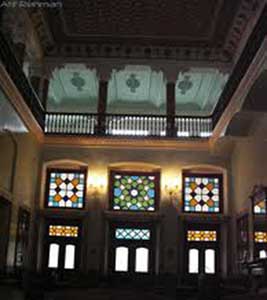DAMASCUS, (ST) – Al- Marjeh Square has a unique location in the middle of Damascus city. It links between the past and the present. It combines between ancient and modern patterns of architecture, between residential buildings and commercial markets.
The square was given the name “Al Marjeh” (a field of grass) because of the large orchards and greenery that were around. Later, it was renamed “The Martyrs’ Square” to commemorate the martyrs of freedom and the men of science, culture and politics, who were executed in 1916 the late Ottoman era.
Among the historic buildings that have spread inside and on the edge of the square is Al Ghazi Palace, in the western angle of the square, which combined with the Al- Basrori Mosque to form an archaeological landmark dating to an era that witnessed the establishment of the modern residential architecture in Damascus. During that new era, stone and ceramic were used in construction in addition to the absence of inner yards in these houses.
The owner of the palace, Ms. Amal Ghazi, said: “This palace was built by her grandfather Ahmed Shaker Ghazi, one of the Damascene landowners in 1814 on the banks of Barada River.”
“The palace consists of three floors being built in a French rustic style which was common at that era. The front of the building was ornamented with various decorations that were common in that era in addition to various motifs and included some components of the Persian construction including arches and some ornamentations, taking into consideration the maintenance of the Damascene character.” Ms. Ghazi described the landmarks of the palace.
“The palace is the only one of its kind that belongs to the period in which the “Saraya” (palace) was built and currently occupied by the Ministry of Interior, noting that a solo independent room with a wooden roof was set up at the top of the front alongside another room was installed with holes of glass called “Al Tayara” and above it there is a primitive old design equipment to calculate the speed and the direction of wind. The stair is broad of a specific character of luxury and eastern drawings,” Ms. Ghazi pointed out.
Ms. Ghazi retrieved her memories in the palace, its columns and decorations as a building tells the Damascene civilization heritage. It constitutes a rich museum that depicts the lives of the Syrian people 200 years ago under the attention of the family in the palace and maintaining the different acquisitions of inscriptions, images and statues.
Director of Damascus Countryside Antiquities, Dr. Mahmoud Hammoud, his Directorate occupies the second and the third floors of the palace, explained that Al Ghazi Palace represents a turning point in the evolution of architecture in Damascus. It is known that the Shami House was built of bricks and wood.
“Damascus governorate has long wanted to turn the square into a modern urban style, but the concern of the owners of the palace in its historical significance urged them to register the palace in the Antiquities Bureau to protect it from demolition,” Dr. Hammoud added.
The director explained the design in which the palace’s arches were built which came on curved and pointed in the head and the second is convex and normal and both arches are based on stone pillars along with decorations that appeared in the front above the windows and on the edges.
For his part, Eng. Mohamed Tawfiq Malass who hires an office inside the palace said that the palace represents a new phase in the architecture but who enters the palace feels immediately that he is inside a Damascene original house through small details such as marble seats and decorated arches.
artistic
There is no doubt that the two hundred- year age palace and the unique design in which it was built, in terms of pairing between the European and the Damascene arts of architecture, will give the palace double importance, encouraging incentive for promotion of the palace and giving it the value it deserves.
Sh. Kh.

